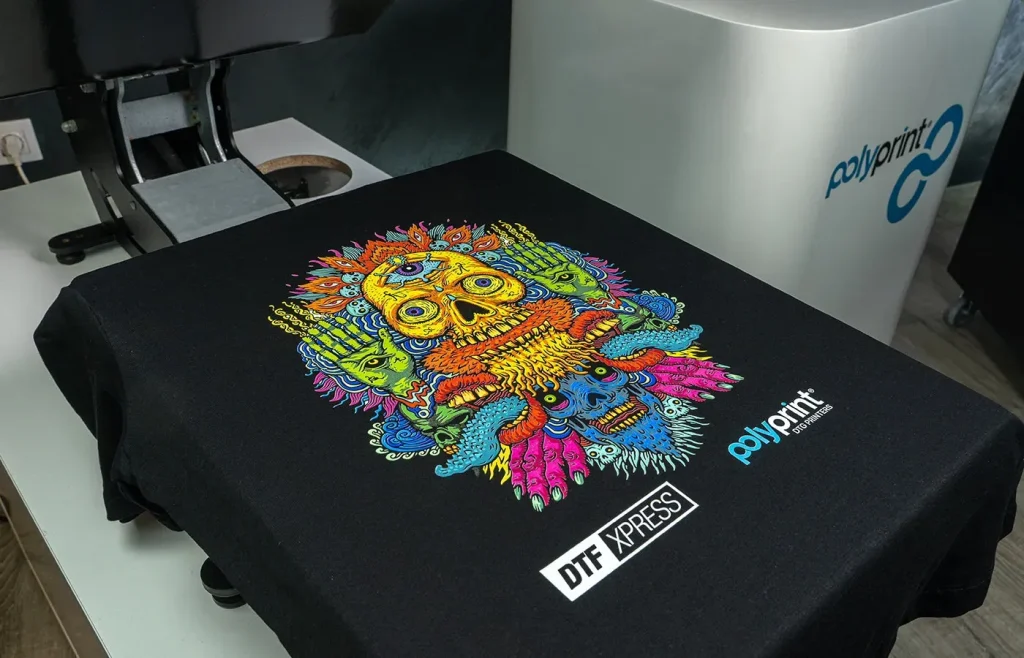DTF printing, or direct to film printing, has emerged as a groundbreaking technique for creating custom designs on textiles, captivating creators and entrepreneurs alike. By utilizing a DTF printer, this innovative printing method allows for stunning full-color graphics to be heat transferred onto a variety of fabrics. As DTF printing continues to rise in popularity, it’s becoming the go-to choice for custom apparel printing, offering endless possibilities for creativity and personalization. In this guide, we’ll explore DTF printing for beginners, demystifying the process and providing essential tips to kick-start your journey in heat transfer printing. With its versatility and cost-effectiveness, DTF printing is the perfect solution for small business owners looking to make their mark in the textile industry.
Introducing this exciting method of fabrication, direct-to-film techniques combine the latest advancements in printing technology with the art of fabric customization. Often referred to as DTF transfer printing, this approach involves applying vibrant designs onto specialized films, which can then be effortlessly transferred onto any fabric, from cotton to blends. With a focus on bolstering the custom apparel market, DTF printers provide an accessible entry point for individuals keen on producing high-quality textiles. This method’s efficiency sets it apart from traditional options, making it a favored choice among creatives and small enterprises. By embracing heat transfer printing, you can unlock a world of opportunities in personalized merchandise and unique garment designs.
Understanding DTF Printing Basics
DTF printing, or Direct to Film printing, is an innovative technology designed for creating vibrant, high-quality prints on textiles. Unlike traditional methods, DTF printing utilizes a special film to transfer designs directly onto fabric surfaces. This method not only enhances the color saturation and detail of prints but also makes it possible to work with a wider variety of materials including cotton and polyester blends. For beginners in custom apparel printing, grasping the fundamentals of DTF printing is crucial to unlocking its creative potential.
For those starting out, it’s essential to realize that DTF printing is not just about transferring ink; it’s a complete process involving specialized equipment like DTF printers and heat transfer machines. The transition from digital design to a finished product requires understanding key aspects such as the heating process, adhesive application, and print curing. By mastering these components, creators can significantly improve the durability and vibrancy of their textile projects.
The Benefits of Using DTF Printing
One of the most notable advantages of DTF printing is its versatility. This technique allows users to produce designs that can be applied to an array of fabrics and products, from T-shirts and hoodies to bags and caps. The ease of transferring designs to different materials boosts creativity, making it an ideal choice for small business owners and hobbyists looking to expand their product lines in custom apparel printing.
Additionally, DTF printing is known for its cost-effectiveness, especially for smaller production runs. Unlike screen printing, which often requires a significant upfront investment in screens and setup, DTF printing can be executed with relatively low initial costs. This benefit allows new businesses to test designs without the financial burden associated with traditional printing methods, making DTF an attractive option for startups and independent creators.
Essential Equipment for DTF Printing
To successfully engage in DTF printing, an investment in the right equipment is essential. First and foremost, having a specialized DTF printer that can handle white inks is vital for achieving high-quality results. Additionally, a reliable heat press machine is crucial, as it helps seal the designs onto the fabric effectively. With these key tools, anyone starting in the DTF printing space can produce impressive results.
Further, investing in quality DTF transfer films and adhesive powder is critical for ensuring that prints adhere properly and retain their vibrancy even after multiple washes. Using subpar materials can lead to peeling or fading, which defeats the purpose of high-quality printing. Beginners should focus on sourcing reputable suppliers for their DTF materials to achieve optimal outcomes in their projects.
Getting Started with DTF Printing Techniques
Once you have the necessary equipment, getting started with DTF printing involves a few foundational steps. First, understanding printer settings is crucial. Beginners should familiarize themselves with their DTF printer’s specifications, adjusting settings such as ink saturation and resolution to optimize print quality. This technical knowledge will set the groundwork for producing vibrant designs that stand out.
Another important aspect is mastering the heat press settings. Getting the temperature, time, and pressure just right can make or break a DTF transfer. Beginners should take the time to conduct trial runs to experiment with different settings, ensuring they find the optimal conditions for their specific fabrics. This process of experimentation not only enhances their technical skills but also boosts confidence in their printing abilities.
Creative Applications of DTF Printing
The applications of DTF printing extend far beyond personal use; this method is ideal for creating custom apparel for businesses, events, and promotions. Many entrepreneurs leverage DTF printing to design bespoke merchandise that captures their brand’s identity. Whether it’s a unique T-shirt for a music festival or promotional bags for a business, the ability to print intricate designs on various materials makes DTF printing an excellent option for customized products.
Moreover, DTF printing can be utilized for creating artwork on items that enhance customer engagement. Personalized gifts or corporate giveaway items like custom hats and jackets can significantly impact customer relationships and brand loyalty. This adaptability of DTF printing not only expands creative horizons but also paves the way for infinite possibilities in the realm of promotional products.
Exploring Recent Trends in DTF Printing
The DTF printing landscape is rapidly evolving, driven by advancements in technology and an increasing demand for customized products. Recent innovations in printing machines and inks have made DTF printing more accessible and cost-effective for small businesses. This growth trend signifies a shift in how creators engage with custom textile printing, opening new avenues for artistic expression and entrepreneurship.
As the DTF printing industry gains momentum, the emphasis on sustainability and eco-friendly options is also rising. Many manufacturers are now focusing on producing inks and films that are less harmful to the environment, aligning with consumer preferences for sustainable practices. This trend not only caters to a more eco-conscious market but also encourages creators to consider their impact on the environment as they embark on their DTF printing journeys.
Frequently Asked Questions
What is DTF printing and how does it work?
DTF printing, or direct to film printing, is a process where designs are printed onto a special transfer film, which is then heat transferred onto fabrics such as cotton or polyester. The DTF printer utilizes high-quality inks to create vibrant, detailed designs that are adhered to the fabric using a heat press.
What equipment do I need for DTF printing?
To start DTF printing, you’ll need a specialized DTF printer capable of handling white ink, high-quality DTF transfer films, adhesive powder, and a reliable heat press machine for transferring your designs onto fabrics.
Can I use DTF printing on different types of fabric?
Yes, DTF printing is versatile and can be used on a variety of fabrics, including cotton, polyester, and their blends. This makes it suitable for custom apparel printing on T-shirts, hoodies, bags, and more.
What are the advantages of using DTF printing over other printing methods?
DTF printing offers several advantages, including the ability to create vibrant full-color designs, versatility across different fabric types, and cost-effectiveness for smaller print runs compared to traditional methods like screen printing.
How can beginners get started with DTF printing?
Beginners can start with DTF printing by investing in quality printer equipment, mastering heat press settings for successful transfers, experimenting with different printer configurations, and joining online communities for support and tips.
What are the most common applications for DTF printing?
DTF printing is commonly used for creating custom apparel such as T-shirts and hoodies, producing unique merchandise for businesses, and generating promotional products featuring eye-catching designs.
| Key Point | Details |
|---|---|
| What is DTF Printing? | A method of printing designs directly onto a film which is then heat transferred onto fabrics like cotton or polyester. |
| The Printing Process | 1. Print design on DTF film. 2. Apply powder adhesive. 3. Cure ink with heat before transferring. |
| Advantages of DTF Printing | Versatile, vibrant, and cost-effective for small runs compared to traditional methods like screen printing. |
| Essential Equipment | Specialized DTF printer, heat press machine, DTF transfer film, and adhesive powder are crucial for success. |
| Beginner Tips | Invest in quality materials, experiment with printer settings, master heat press techniques, and learn from experts. |
| Applications of DTF Printing | Custom apparel, merchandising, and promotional products showcase the flexibility of DTF printing. |
| Recent Trends | The demand for custom products is driving growth in DTF printing, making it more accessible to creators. |
Summary
DTF printing is an innovative and accessible technique for custom textile production. As a beginner delving into this dynamic field, you will find DTF printing not only enhances your creative projects but also opens up exciting business possibilities. With its ability to deliver vibrant, high-quality designs on various materials, understanding the DTF printing process can significantly boost your endeavors in the custom printing industry. By investing in the right equipment and materials and continuously learning from expert resources, you can achieve stunning results that appeal to diverse markets. So embrace DTF printing, and let your creativity flourish!



